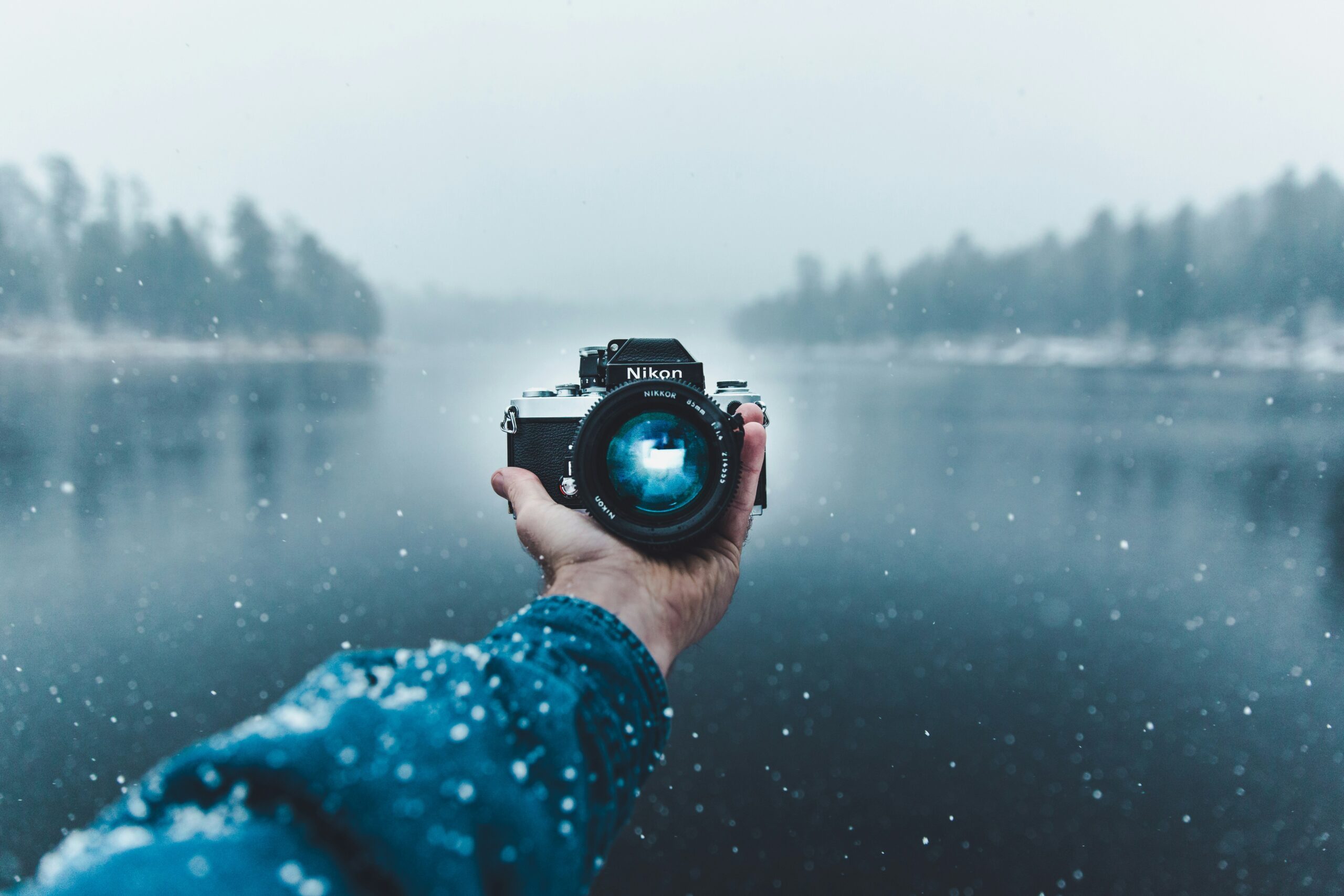Introduction:
Best Travel Camera, In the era of social media and wanderlust, capturing breathtaking moments during your travels has become an essential part of the experience. To ensure that you don’t miss a single detail, having the right camera by your side is crucial. we will explore and guide you through the world of travel cameras, helping you find the perfect companion for your adventures.
Understanding the Need:
When it comes to travel photography, the requirements for a camera are unique. It needs to be compact, lightweight, and versatile enough to capture diverse landscapes and scenarios. The primary challenge is finding a camera that strikes the perfect balance between portability and advanced features. With the plethora of options available, it can be overwhelming to make the right choice. Fear not, as we have curated a list of the best travel cameras that cater to various preferences and budgets.
Sony RX100 VII:
Topping our list is the Sony RX100 VII, renowned for its exceptional image quality and compact design. Packed with a 1-inch sensor, 24-200mm zoom lens, and impressive autofocus capabilities, this camera ensures stunning shots in any environment. Its pocket-sized form factor makes it an ideal travel companion without compromising on performance.

| Pros | Cons |
|---|---|
| 1. Compact Size: Portable and pocketable design for on-the-go shooting. | 1. High Price: Relatively expensive compared to other compact cameras. |
| 2. 1-inch Sensor: Excellent image quality with a large sensor for its size. | 2. Limited Zoom Range: 24-200mm zoom may be restrictive for some users. |
| 3. Impressive Autofocus: Fast and accurate autofocus system for quick capture. | 3. Small Controls: Controls might be cramped for users with larger hands. |
| 4. 4K Video Recording: Capable of recording high-quality 4K videos. | 4. No Headphone Jack: Lack of a headphone jack for audio monitoring. |
| 5. Tilting Touchscreen: Useful for capturing shots from various angles. | 5. Battery Life: Limited battery life, requiring frequent recharging. |
| 6. Built-in EVF: Electronic viewfinder enhances composition in bright conditions. | 6. Heating Issues: Intensive tasks may lead to the camera getting warm. |
| 7. Versatile Shooting Modes: Offers a variety of shooting modes for different scenarios. | 7. Limited Customization: Limited customization options for advanced users. |
| 8. Wi-Fi and NFC Connectivity: Allows for easy wireless image transfer and sharing. | 8. No Weather Sealing: Not weather-sealed, limiting usability in harsh conditions. |
It’s important to consider these pros and cons based on your specific needs and preferences to determine if the Sony RX100 VII aligns with your photography requirements.
Canon PowerShot G5 X Mark II:
For those who prefer the Canon ecosystem, the PowerShot G5 X Mark II is a compelling choice. This compact camera boasts a 20.1MP 1-inch sensor, a 5x zoom lens, and 4K video recording. The pop-up electronic viewfinder adds versatility, making it perfect for both amateur and advanced photographers on the go.
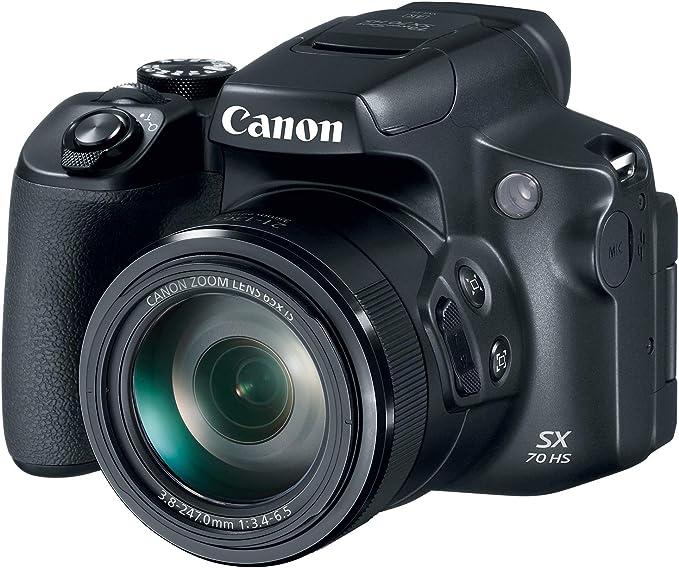
| Pros | Cons |
|---|---|
| 1. Compact and Lightweight: Portable design for easy travel and on-the-go shooting. | 1. Fixed LCD Screen: The LCD screen doesn’t tilt or swivel, limiting flexibility. |
| 2. 20.1MP 1-inch Sensor: High-resolution sensor for excellent image quality. | 2. Limited Zoom Range: 5x zoom might be insufficient for users requiring more reach. |
| 3. Pop-up Electronic Viewfinder: Provides versatility for composing shots in bright conditions. | 3. No Weather Sealing: Not weather-sealed, limiting usability in adverse conditions. |
| 4. 4K Video Recording: Capable of recording high-quality 4K videos. | 4. Limited Battery Life: Battery life is relatively short, requiring frequent recharging. |
| 5. Intuitive Touchscreen: Touchscreen interface for easy menu navigation and focusing. | 5. No Headphone Jack: Lack of a headphone jack for audio monitoring during video recording. |
| 6. Bluetooth and Wi-Fi Connectivity: Allows for easy wireless image transfer and remote control. | 6. Limited Customization: Advanced users may find customization options somewhat restricted. |
| 7. USB Charging: Convenient USB charging option for added flexibility on the go. | 7. Smaller Grip: The grip may be less comfortable for users with larger hands. |
| 8. Fast Autofocus System: Quick and accurate autofocus for capturing sharp images. | 8. Moderate Low-Light Performance: Limited performance in very low-light conditions. |
These pros and cons in the context of your photography preferences and requirements to determine if the Canon PowerShot G5 X Mark II is the right camera for your needs.
Panasonic Lumix ZS200 / TZ200:
Best Travel Camera, Panasonic Lumix ZS200, also known as TZ200, impresses with its 1-inch sensor, 15x zoom lens, and 4K video capabilities. Its compact design and excellent image stabilization make it an excellent choice for capturing dynamic scenes during your travels. The electronic viewfinder and touchscreen further enhance the user experience.

| Pros | Cons |
|---|---|
| 1. Large 1-inch Sensor: Impressive image quality for a compact camera. | 1. Fixed LCD Screen: The LCD screen is fixed and doesn’t articulate. |
| 2. 15x Optical Zoom: Versatile zoom range covering wide-angle to telephoto. | 2. Limited Touchscreen Functionality: Touchscreen functionality is limited. |
| 3. 4K Video Recording: Capable of recording high-quality 4K videos. | 3. Limited EVF Magnification: Electronic viewfinder has limited magnification. |
| 4. Post-Focus Feature: Allows users to select the focus point after capturing an image. | 4. No Weather Sealing: Not weather-sealed, limiting use in adverse conditions. |
| 5. Built-in EVF: Electronic viewfinder enhances composition, especially in bright conditions. | 5. Battery Life: Limited battery life, requiring frequent recharging. |
| 6. Quick Autofocus System: Fast and accurate autofocus for capturing sharp images. | 6. Lack of Headphone Jack: Absence of a headphone jack for audio monitoring during video recording. |
| 7. Manual Control Ring: Integrated control ring for manual adjustments during shooting. | 7. Limited Raw Burst Depth: Limited buffer depth for continuous RAW shooting. |
| 8. Wi-Fi Connectivity: Allows for wireless image transfer and remote control. | 8. Small Grip: The grip may be less comfortable for users with larger hands. |
If the Panasonic Lumix ZS200 / TZ200 aligns with your expectations for a travel camera.
Fujifilm X-T30:
If you are inclined towards mirrorless cameras, the Fujifilm X-T30 is a standout option. With its APS-C sensor, 4K video recording, and compact design, this camera caters to photography enthusiasts who seek both performance and portability. The retro design adds a touch of style to your travel gear.

| Pros | Cons |
|---|---|
| 1. Large 1-inch Sensor: Impressive image quality for a compact camera. | 1. Fixed LCD Screen: The LCD screen is fixed and doesn’t articulate. |
| 2. 15x Optical Zoom: Versatile zoom range covering wide-angle to telephoto. | 2. Limited Touchscreen Functionality: Touchscreen functionality is limited. |
| 3. 4K Video Recording: Capable of recording high-quality 4K videos. | 3. Limited EVF Magnification: Electronic viewfinder has limited magnification. |
| 4. Post-Focus Feature: Allows users to select the focus point after capturing an image. | 4. No Weather Sealing: Not weather-sealed, limiting use in adverse conditions. |
| 5. Built-in EVF: Electronic viewfinder enhances composition, especially in bright conditions. | 5. Battery Life: Limited battery life, requiring frequent recharging. |
| 6. Quick Autofocus System: Fast and accurate autofocus for capturing sharp images. | 6. Lack of Headphone Jack: Absence of a headphone jack for audio monitoring during video recording. |
| 7. Manual Control Ring: Integrated control ring for manual adjustments during shooting. | 7. Limited Raw Burst Depth: Limited buffer depth for continuous RAW shooting. |
| 8. Wi-Fi Connectivity: Allows for wireless image transfer and remote control. | 8. Small Grip: The grip may be less comfortable for users with larger hands. |
photography preferences and needs to determine if the Panasonic Lumix ZS200 / TZ200 aligns with your expectations for a travel camera.
DJI Osmo Pocket:
For those who prioritize video as much as photography, the DJI Osmo Pocket is a game-changer. This compact gimbal-stabilized camera captures smooth 4K footage, making it perfect for vlogging and documenting your adventures. Its pocket-sized design ensures hassle-free portability.

| Pros | Cons |
|---|---|
| 1. Compact and Portable: Extremely small and easy to carry for on-the-go filming. | 1. Fixed Field of View: Fixed 26mm lens limits framing options. |
| 2. Gimbal Stabilization: Integrated 3-axis gimbal ensures smooth and stable footage. | 2. Small Touchscreen: Limited screen real estate for menu navigation and framing. |
| 3. 4K Video Capability: Capable of recording high-quality 4K videos at 60fps. | 3. Non-Removable Battery: The built-in battery is not user-replaceable. |
| 4. Face and Object Tracking: Advanced tracking features for automated subject tracking. | 4. Limited Audio Options: Built-in microphones may not capture high-quality audio in all situations. |
| 5. User-Friendly Interface: Simple and intuitive controls for quick and easy operation. | 5. No External Mic Input: Lacks a port for connecting an external microphone. |
| 6. Time-Lapse and Slow Motion: Offers creative shooting modes like time-lapse and slow-motion. | 6. Limited Manual Controls: Limited manual settings for advanced users. |
| 7. Motion Timelapse: Automated motion timelapse feature adds cinematic flair to videos. | 7. No Viewfinder: Lacks an electronic viewfinder for precise framing in bright conditions. |
| 8. Wide Range of Accessories: Various accessories available for expanding functionality. | 8. Fixed Aperture: Fixed f/2.0 aperture may limit low-light performance. |
Consider these pros and cons based on your videography needs and preferences to determine if the DJI Osmo Pocket is the right camera for your portable filming requirements.
Nikon Z50:
The Nikon Z50 is a mirrorless camera that strikes a balance between performance and portability. With a DX-format sensor, 4K video recording, and a compact build, it’s an excellent choice for travelers who want the versatility of interchangeable lenses without compromising on size.
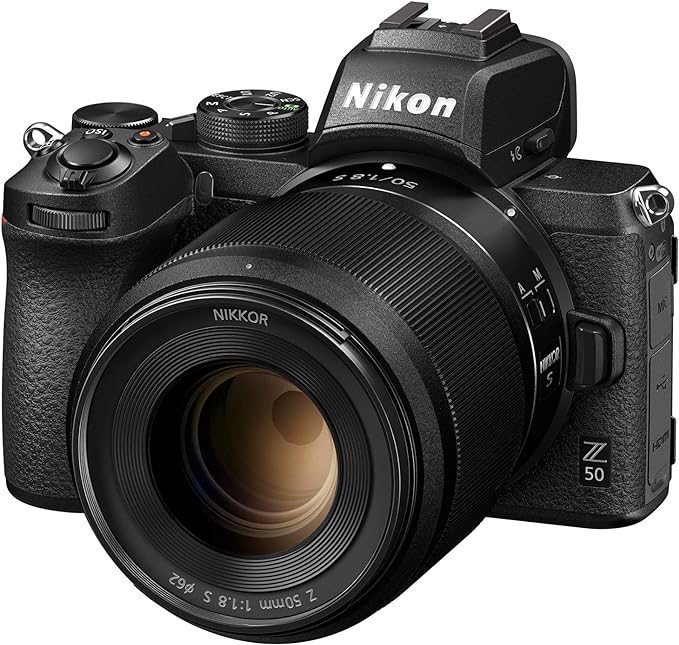
| Pros | Cons |
|---|---|
| 1. Compact and Lightweight: Portable design for easy travel and everyday use. | 1. Single Card Slot: Only one SD card slot may be limiting for professionals. |
| 2. 20.9MP APS-C Sensor: High-resolution sensor for detailed and sharp images. | 2. Limited Native Z-Mount Lenses: Smaller lens selection compared to some competitors. |
| 3. In-Body Image Stabilization: Built-in image stabilization for steady shots. | 3. 4K Video Crop: 4K video has a crop factor, affecting field of view. |
| 4. Hybrid Autofocus System: Fast and accurate autofocus for both stills and video. | 4. No In-Body Flash: Absence of a built-in flash may limit low-light capabilities. |
| 5. 4K Video Recording: Capable of recording high-quality 4K videos at 30fps. | 5. Smaller Grip: The grip may be less comfortable for users with larger hands. |
| 6. Tilting Touchscreen: Articulating touchscreen for flexible framing and menu navigation. | 6. Limited Battery Life: Battery life may be relatively short, requiring extra batteries. |
| 7. Electronic Viewfinder: Built-in EVF for composing shots in bright conditions. | 7. No Weather Sealing: Not fully weather-sealed, limiting use in adverse conditions. |
| 8. Compatibility with F-Mount Lenses: Adapter available for using Nikon’s extensive F-mount lenses. | 8. Limited Native Z-Mount Lens Options: Smaller selection compared to other mirrorless systems. |
Consider these pros and cons in the context of your photography preferences and requirements to determine if the Nikon Z50 is the right camera for your needs.
Canon EOS M6 Mark II:
Canon’s EOS M6 Mark II is a mirrorless camera that boasts a high-resolution APS-C sensor, impressive autofocus, and 4K video capabilities. Its compact size and intuitive controls make it an ideal companion for capturing stunning images on the go.
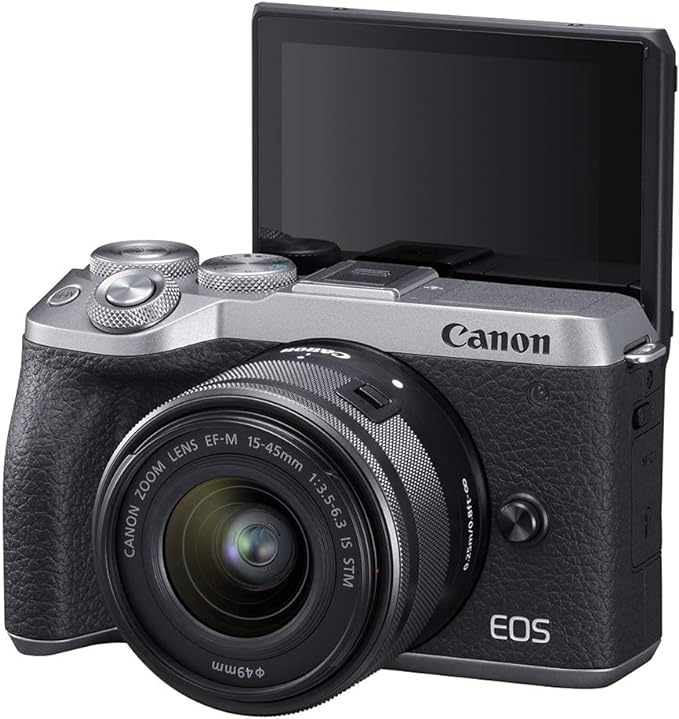
| Pros | Cons |
|---|---|
| 1. Compact and Lightweight: Portable design for easy travel and everyday use. | 1. Limited Battery Life: Battery life may be relatively short, requiring extra batteries. |
| 2. 32.5MP APS-C Sensor: High-resolution sensor for detailed and sharp images. | 2. Electronic Viewfinder (Optional): Requires an additional accessory for an electronic viewfinder. |
| 3. Dual Pixel CMOS Autofocus: Fast and accurate autofocus for both stills and video. | 3. Limited Native Lens Selection: Smaller selection compared to other mirrorless systems. |
| 4. 4K Video Recording: Capable of recording high-quality 4K videos at 30fps. | 4. No In-Body Image Stabilization: Relies on lens stabilization for stable shots. |
| 5. Tilting Touchscreen: Articulating touchscreen for flexible framing and menu navigation. | 5. No Weather Sealing: Not fully weather-sealed, limiting use in adverse conditions. |
| 6. Up to 14fps Continuous Shooting: High-speed shooting for capturing fast-paced action. | 6. Crop Factor in 4K: 4K video has a crop factor, affecting field of view. |
| 7. Compatibility with EF-M and EF/EF-S Lenses: Adapter available for using a wide range of Canon lenses. | 7. No Built-In Image Stabilization: Lack of in-body stabilization can affect handheld shooting in low light. |
| 8. Wi-Fi and Bluetooth Connectivity: Allows for wireless image transfer and remote control. | 8. Single Card Slot: Only one SD card slot may be limiting for professionals. |
Consider these pros and cons in the context of your photography preferences and requirements to determine if the Canon EOS M6 Mark II is the right camera for your needs.
Olympus OM-D E-M10 Mark IV:
The Olympus OM-D E-M10 Mark IV is a Micro Four Thirds mirrorless camera known for its compact design and powerful features. With in-body image stabilization, 4K video, and a user-friendly interface, it’s a great option for travelers who prioritize ease of use and image quality.

| Pros | Cons |
|---|---|
| 1. Compact and Lightweight: Portable design for easy travel and everyday use. | 1. Smaller Micro Four Thirds Sensor: Smaller sensor size compared to some competitors. |
| 2. 20.3MP Micro Four Thirds Sensor: Good balance of resolution and low-light performance. | 2. Limited Native Lens Selection: Smaller selection compared to other systems. |
| 3. In-Body Image Stabilization: Built-in image stabilization for steady shots. | 3. Electronic Viewfinder Not Tilted: EVF doesn’t tilt for flexible framing. |
| 4. 4K Video Recording: Capable of recording high-quality 4K videos at 30fps. | 4. C-AF Performance: Continuous autofocus may not be as advanced as some competitors. |
| 5. Tilting Touchscreen: Articulating touchscreen for flexible framing and menu navigation. | 5. Lower Resolution EVF: Electronic viewfinder has a lower resolution compared to some rivals. |
| 6. 8.7fps Continuous Shooting: Decent continuous shooting speed for capturing action. | 6. Smaller Grip: The grip may be less comfortable for users with larger hands. |
| 7. Wi-Fi Connectivity: Allows for wireless image transfer and remote control. | 7. No Weather Sealing: Not fully weather-sealed, limiting use in adverse conditions. |
| 8. Creative Shooting Modes: Art filters and creative modes for diverse photography styles. | 8. Autofocus in Low Light: Autofocus performance may be affected in low-light conditions. |
Consider these pros and cons in the context of your photography preferences and requirements to determine if the Olympus OM-D E-M10 Mark IV is the right camera for your needs.
Sony A6400:
Sony’s A6400 is a mirrorless camera designed for enthusiasts and professionals alike. It features a 24.2MP APS-C sensor, 4K video recording, and impressive autofocus capabilities. The compact size and flip-up touchscreen make it an excellent choice for capturing travel moments with ease.

| Pros | Cons |
|---|---|
| 1. Compact and Lightweight: Portable design for easy travel and everyday use. | 1. Limited Battery Life: Battery life may be relatively short, requiring extra batteries. |
| 2. 24.2MP APS-C Sensor: High-resolution sensor for detailed and sharp images. | 2. No In-Body Image Stabilization: Relies on lens stabilization for stable shots. |
| 3. Real-time Eye Autofocus: Advanced autofocus system for precise eye tracking. | 3. Limited Touchscreen Articulation: Tilting screen but doesn’t fully articulate. |
| 4. 4K Video Recording: Capable of recording high-quality 4K videos at 30fps. | 4. Limited Weather Sealing: Not fully weather-sealed, limiting use in adverse conditions. |
| 5. 11fps Continuous Shooting: High-speed shooting for capturing fast-paced action. | 5. No In-Body Flash: Absence of a built-in flash may limit low-light capabilities. |
| 6. 180-Degree Tilting Touchscreen: Tilting screen for flexible framing and vlogging. | 6. Single Card Slot: Only one SD card slot may be limiting for professionals. |
| 7. Wi-Fi and Bluetooth Connectivity: Allows for wireless image transfer and remote control. | 7. Moderate Buffer Size: Limited buffer size for continuous shooting in RAW. |
| 8. Wide ISO Range: Good low-light performance with a wide ISO range. | 8. Small Grip: The grip may be less comfortable for users with larger hands. |
Consider these pros and cons in the context of your photography preferences and requirements to determine if the Sony A6400 is the right camera for your needs.
Ricoh GR III:
The Ricoh GR III is a compact camera that caters to street photographers and travel enthusiasts who prioritize image quality in a pocket-sized device. With its large APS-C sensor, 28mm fixed lens, and portability, it’s perfect for capturing spontaneous moments during your journeys.

| Pros | Cons |
|---|---|
| 1. Compact and Lightweight: Extremely portable design for discreet street photography. | 1. Fixed 28mm Lens: Fixed focal length may not suit all shooting scenarios. |
| 2. 24.2MP APS-C Sensor: High-resolution sensor for detailed and sharp images. | 2. No Viewfinder: Lacks an electronic or optical viewfinder for precise framing. |
| 3. In-Body Image Stabilization: Built-in stabilization for steady shots in various conditions. | 3. Fixed Touchscreen: The touchscreen functionality is not fully articulated. |
| 4. 3-Axis Shake Reduction: Effective shake reduction for improved handheld shots. | 4. Limited Battery Life: Battery life may be relatively short, requiring extra batteries. |
| 5. High-Quality Build: Durable construction with a magnesium alloy body. | 5. Single Card Slot: Only one SD card slot may be limiting for professionals. |
| 6. Built-in Wi-Fi Connectivity: Allows for wireless image transfer and remote control. | 6. No Weather Sealing: Not fully weather-sealed, limiting use in adverse conditions. |
| 7. Macro Mode: Dedicated macro mode for close-up photography. | 7. Fixed LCD Screen: The LCD screen doesn’t tilt or swivel for varied shooting angles. |
| 8. Minimalist Design: Streamlined interface for a simplified and focused shooting experience. | 8. No Built-In Flash: Absence of a built-in flash may limit low-light capabilities. |
Consider these pros and cons in the context of your photography preferences and requirements to determine if the Ricoh GR III is the right camera for your needs, especially if you appreciate a fixed focal length and prioritize portability for street photography.
Leica Q2:
For those who appreciate luxury and uncompromising image quality, the Leica Q2 is a premium compact camera. With a full-frame sensor, weather-sealed build, and a fixed 28mm lens, it delivers exceptional results in a beautifully crafted package, making it a statement piece for discerning travelers.

| Pros | Cons |
|---|---|
| 1. Full-Frame Sensor: High-resolution full-frame sensor for exceptional image quality. | 1. High Price: Leica cameras are known for their premium pricing. |
| 2. 28mm f/1.7 Summilux Lens: Fast and sharp prime lens for versatile shooting. | 2. Fixed Lens: Fixed focal length may not suit all shooting preferences. |
| 3. Built-in Viewfinder: Integrated electronic viewfinder for precise composition. | 3. Limited Zoom Range: Fixed lens limits versatility in framing. |
| 4. Weather-Sealed Construction: Robust and weather-sealed design for durability. | 4. Heavy Build: The camera is relatively heavy, affecting portability. |
| 5. 4K Video Recording: Capable of recording high-quality 4K videos at 24fps. | 5. No Articulating Screen: The LCD screen doesn’t tilt or swivel for varied shooting angles. |
| 6. Minimalist Design: Sleek and elegant design with straightforward controls. | 6. No Image Stabilization: Lack of in-body stabilization may affect handheld shooting in low light. |
| 7. Fast Autofocus System: Quick and accurate autofocus for various shooting scenarios. | 7. Single Card Slot: Only one SD card slot may be limiting for professionals. |
| 8. Large and Bright LCD Screen: 3.0-inch touchscreen LCD for easy menu navigation. | 8. Fixed Touchscreen Functionality: Limited touchscreen functionality compared to some rivals. |
Consider these pros and cons in the context of your photography preferences and requirements to determine if the Leica Q2’s premium features align with your needs and justify the investment.
GoPro HERO10 Black:
If your travels involve adventure and action, the GoPro HERO10 Black is a versatile action camera. With 5.3K video recording, excellent stabilization, and a rugged design, it’s perfect for capturing adrenaline-filled moments, whether you’re hiking, snorkeling, or engaging in other outdoor activities.
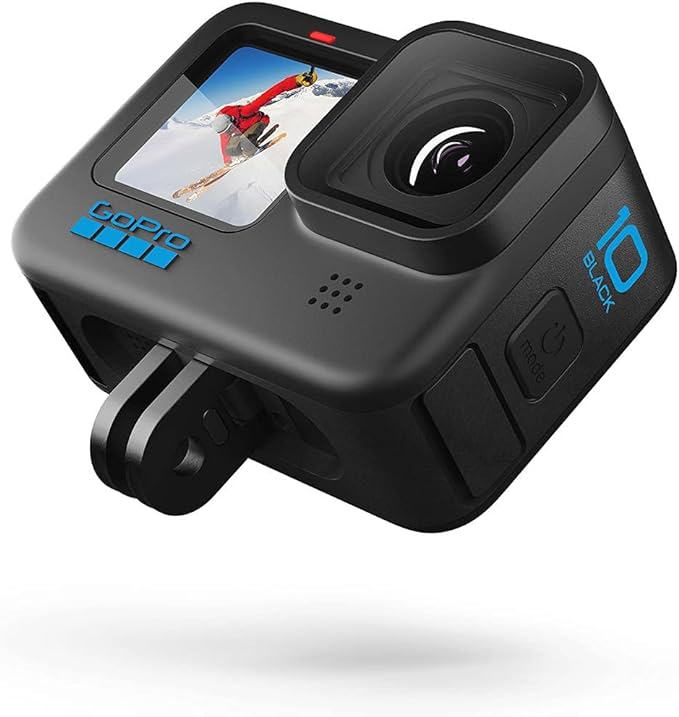
| Pros | Cons |
|---|---|
| 1. Compact and Rugged Design: Portable and durable for various adventure activities. | 1. High Price: Positioned as a premium action camera, it comes with a higher cost. |
| 2. 5.3K Video Recording: Capable of recording high-resolution 5.3K videos at 60fps. | 2. Battery Life: Continuous use may require additional batteries for extended recording. |
| 3. HyperSmooth 4.0 Stabilization: Advanced stabilization for smooth and steady footage. | 3. Fixed Lens: Non-removable lens may limit flexibility for some users. |
| 4. SuperPhoto + HDR: Enhanced photo quality with high dynamic range capabilities. | 4. Limited Low-Light Performance: Small sensor may struggle in low-light conditions. |
| 5. TimeWarp 4.0: Creative time-lapse feature with stabilization for dynamic videos. | 5. Touchscreen Controls: Touchscreen controls may be challenging in wet conditions. |
| 6. 1080p Live Streaming: Capability to livestream in Full HD for real-time sharing. | 6. No Manual Exposure Control: Limited manual settings for advanced users. |
| 7. Waterproof without Housing: Waterproof design for underwater use without additional housing. | 7. No External Mic Input: Limited audio options for users who prefer external microphones. |
| 8. Built-in Wi-Fi and Bluetooth: Allows for wireless connectivity and remote control. | 8. Limited Zoom Capability: Fixed lens with no optical zoom functionality. |
Consider these pros and cons in the context of your action photography and videography needs to determine if the GoPro HERO10 Black is the right camera for capturing your adventures.
Panasonic Lumix GH5:
Targeted towards videographers and hybrid shooters, the Panasonic Lumix GH5 is a Micro Four Thirds mirrorless camera. With advanced video features, including 4K at 60fps and 10-bit internal recording, it’s a powerhouse for capturing high-quality footage during your travels.
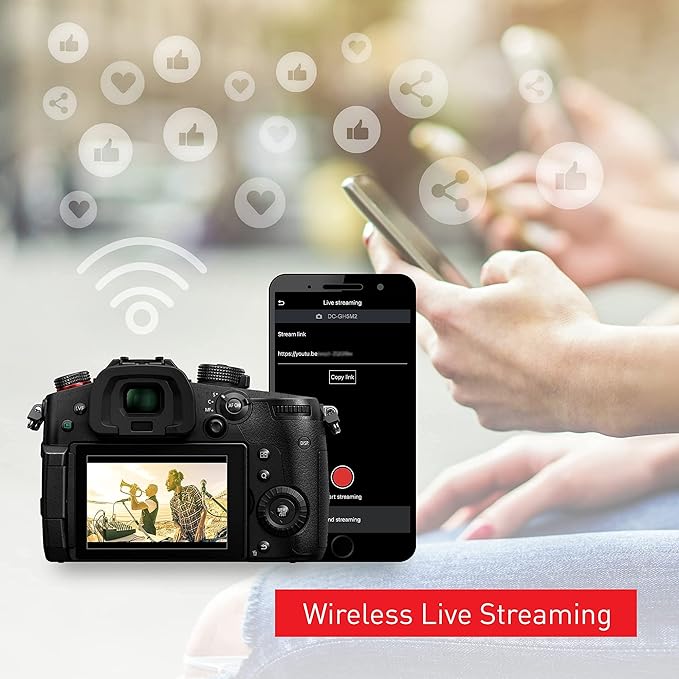
| Pros | Cons |
|---|---|
| 1. Micro Four Thirds Sensor: Good compromise between size and image quality. | 1. Larger Size: Bulkier compared to some other mirrorless cameras. |
| 2. 20.3MP High-Resolution Sensor: High megapixel count for detailed images. | 2. Smaller Sensor Size: May not perform as well in low light compared to larger sensors. |
| 3. 5-Axis In-Body Stabilization: Effective image stabilization for handheld shots. | 3. Autofocus for Video: Continuous autofocus may not be as advanced as some competitors. |
| 4. 4K Video at 60fps: Capable of recording high-quality 4K videos at a high frame rate. | 4. No Phase Detection Autofocus: Autofocus relies on contrast-detection, which may be slower in certain situations. |
| 5. Dual UHS-II SD Card Slots: Dual card slots for extended storage and backup options. | 5. Short Battery Life: Battery life may be relatively short, requiring extra batteries. |
| 6. Professional Video Features: V-LogL, 4:2:2 10-bit internal recording for video enthusiasts. | 6. Bulky Design: Larger size may be less convenient for travel or casual shooting. |
| 7. Vari-Angle Touchscreen: Articulating touchscreen for flexible framing and easy menu navigation. | 7. Smaller Native Lens Selection: Smaller selection of native lenses compared to some rivals. |
| 8. Weather-Sealed Construction: Robust design for durability in various shooting conditions. | 8. Learning Curve: Extensive features may have a steeper learning curve for beginners. |
Consider these pros and cons in the context of your photography and videography preferences to determine if the Panasonic Lumix GH5 aligns with your specific needs, especially if you prioritize advanced video features and professional capabilities.
Canon PowerShot SX740 HS:
If you’re seeking a compact point-and-shoot camera with an extensive zoom range, the Canon PowerShot SX740 HS is an excellent choice. With a 40x optical zoom lens, 4K video capabilities, and a compact design, it’s perfect for capturing distant landscapes and memorable moments on your journeys.

| Pros | Cons |
|---|---|
| 1. Compact and Lightweight: Portable design for easy travel and everyday use. | 1. Smaller Sensor Size: 1/2.3-inch sensor may limit low-light performance. |
| 2. 40x Optical Zoom: Versatile zoom range covering wide-angle to telephoto. | 2. Fixed LCD Screen: The LCD screen doesn’t tilt or swivel for varied shooting angles. |
| 3. 4K Video Recording: Capable of recording 4K videos for high-quality footage. | 3. Limited Manual Controls: Manual settings are limited compared to advanced cameras. |
| 4. DIGIC 8 Image Processor: Efficient image processing for better overall performance. | 4. No Viewfinder: Lacks an electronic or optical viewfinder for precise framing. |
| 5. 10fps Continuous Shooting: Fast continuous shooting for capturing action sequences. | 5. Limited Low-Light Performance: Small sensor may struggle in low-light conditions. |
| 6. Bluetooth and Wi-Fi Connectivity: Allows for wireless image transfer and remote control. | 6. No Raw Shooting: Limited control over post-processing due to lack of Raw support. |
| 7. In-Camera Panorama Mode: Built-in panorama mode for capturing wide scenic views. | 7. No Manual Focus Ring: Lack of a manual focus ring may limit control for some users. |
| 8. Pop-up Flash: Built-in flash for additional light in low-light conditions. | 8. Plastic Build: The camera’s construction is primarily plastic, potentially less durable. |
Consider these pros and cons in the context of your photography needs and preferences to determine if the Canon PowerShot SX740 HS is the right camera for your requirements, especially if you prioritize a compact design and versatile zoom capabilities.
Sony A7C:
The Sony A7C is a full-frame mirrorless camera known for its compact and lightweight design. With a 24.2MP sensor, advanced autofocus, and 4K video recording, it’s an ideal choice for travel photographers who want the benefits of a full-frame sensor without the bulk.

| Pros | Cons |
|---|---|
| 1. Full-Frame Sensor: Excellent image quality with a large 24.2MP sensor. | 1. Smaller Battery Life: Battery life may be relatively short, requiring extra batteries. |
| 2. Compact and Lightweight: Portable design for a full-frame mirrorless camera. | 2. Single Card Slot: Only one SD card slot may be limiting for professionals. |
| 3. Real-time Eye Autofocus: Advanced autofocus system for precise eye tracking. | 3. Limited Native Lens Selection: Smaller selection compared to some competitors. |
| 4. 4K Video Recording: Capable of recording high-quality 4K videos at 30fps. | 4. No In-Body Image Stabilization: Relies on lens stabilization for stable shots. |
| 5. Tilting Touchscreen: Articulating touchscreen for flexible framing and menu navigation. | 5. No Built-In Flash: Absence of a built-in flash may limit low-light capabilities. |
| 6. Viewfinder and LCD: Built-in electronic viewfinder and a tilting LCD screen. | 6. Higher Price Point: Positioned in a higher price range for mirrorless cameras. |
| 7. Wi-Fi and Bluetooth Connectivity: Allows for wireless image transfer and remote control. | 7. No Joystick for AF Point Selection: Lack of a joystick may affect quick AF point adjustments. |
| 8. Wide ISO Range: Good low-light performance with a wide native ISO range. | 8. Limited Weather Sealing: Not fully weather-sealed, limiting use in adverse conditions. |
Consider these pros and cons in the context of your photography preferences and requirements to determine if the Sony A7C is the right camera for your needs, especially if you prioritize a compact full-frame camera with advanced autofocus capabilities.
Fujifilm X100V:
For those who appreciate classic design and exceptional image quality, the Fujifilm X100V is a premium compact camera. It features a large APS-C sensor, a fixed 23mm f/2 lens, and a hybrid viewfinder. The X100V is perfect for capturing timeless moments during your travels.

| Pros | Cons |
|---|---|
| 1. APS-C Sensor: High-quality images with a large 26.1MP APS-C sensor. | 1. Fixed Lens: Fixed 23mm f/2 lens may not suit all shooting scenarios. |
| 2. Advanced Hybrid Viewfinder: Versatile optical/electronic viewfinder for framing options. | 2. No In-Body Image Stabilization: Lack of in-body stabilization for handheld shots. |
| 3. Tilting Touchscreen: 3-inch LCD screen tilts for flexible framing and menu navigation. | 3. Fixed Touchscreen: Limited tilting functionality for varied shooting angles. |
| 4. X-Trans CMOS IV Sensor: Fujifilm’s sensor technology provides unique color rendering. | 4. Single Card Slot: Only one SD card slot may be limiting for professionals. |
| 5. Classic Design and Build: Retro-inspired design with high-quality construction. | 5. No Weather Sealing: Not fully weather-sealed, limiting use in adverse conditions. |
| 6. 4K Video Recording: Capable of recording high-quality 4K videos at 30fps. | 6. Higher Price Point: Positioned at a higher price range for a fixed lens camera. |
| 7. Built-In ND Filter: Integrated ND filter for controlling exposure in bright conditions. | 7. Moderate Battery Life: Battery life may be relatively short, requiring extra batteries. |
| 8. Film Simulation Modes: Various film simulation modes for creative image styles. | 8. No In-Body Flash: Absence of a built-in flash may limit low-light capabilities. |
Consider these pros and cons in the context of your photography preferences and requirements to determine if the Fujifilm X100V is the right camera for your needs, especially if you appreciate a fixed focal length and a classic design.
Nikon Coolpix P1000:
If zoom capabilities are at the top of your priority list, the Nikon Coolpix P1000 is a superzoom bridge camera with an astonishing 125x optical zoom. Whether capturing wildlife or architectural details, this camera’s impressive reach makes it a standout choice for travelers with a penchant for long-distance shots.

| Pros | Cons |
|---|---|
| 1. 125x Optical Zoom: Remarkable zoom range, covering wide-angle to super-telephoto. | 1. Bulkier Design: Larger and heavier compared to many other bridge cameras. |
| 2. 16MP 1/2.3-inch Sensor: Good resolution for detailed images in well-lit conditions. | 2. Limited Low-Light Performance: Small sensor may struggle in low-light situations. |
| 3. 4K UHD Video Recording: Capable of recording 4K videos at 30fps for high-quality footage. | 3. Fixed LCD Screen: The LCD screen doesn’t tilt or swivel for varied shooting angles. |
| 4. Vari-Angle LCD: Articulating touchscreen LCD for flexible framing and easy menu navigation. | 4. No RAW Support: Limited control over post-processing due to lack of RAW support. |
| 5. Built-In Electronic Viewfinder: Integrated EVF for precise composition, especially in bright conditions. | 5. Limited Aperture Range: Fixed aperture limits control over depth of field. |
| 6. RAW Shooting Option: Allows for greater post-processing flexibility with RAW capture. | 6. No Manual Focus Ring: Lack of a manual focus ring may limit control for some users. |
| 7. Dual Detect Optical Vibration Reduction: Effective image stabilization for reducing camera shake. | 7. Moderate Battery Life: Battery life may be relatively short, especially with extensive zoom usage. |
| 8. Built-In Wi-Fi and Bluetooth: Enables wireless image transfer and remote control. | 8. Limited Customization: Controls and customization options may be less extensive than DSLRs. |
Consider these pros and cons in the context of your photography preferences and requirements, especially if you prioritize a superzoom camera with an extensive focal range.
Ricoh Theta Z1:
For immersive travel experiences, the Ricoh Theta Z1 is a 360-degree camera that captures spherical photos and 4K videos. It’s perfect for documenting your surroundings in a unique and engaging way, providing a different perspective on your adventures.
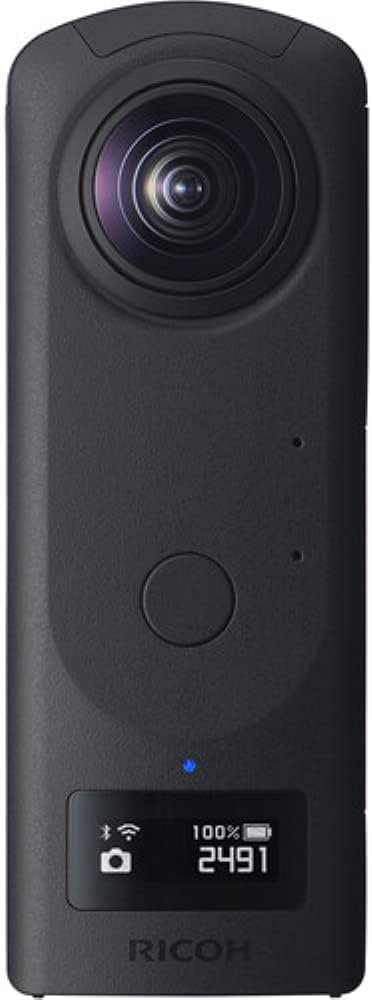
| Pros | Cons |
|---|---|
| 1. 360-Degree Imaging: Captures seamless 360-degree photos and videos. | 1. High Price: Positioned as a premium 360-degree camera, it comes with a higher cost. |
| 2. Dual 1-inch Sensors: Large sensors for improved image quality in 360-degree shots. | 2. Limited Internal Storage: Relatively small internal storage for storing media files. |
| 3. High-Resolution Output: Produces 23MP still images for detailed and sharp results. | 3. Non-Removable Battery: The built-in battery is not user-replaceable. |
| 4. 4K Video Recording: Capable of recording high-quality 4K 360-degree videos. | 4. Limited Third-Party App Support: May have fewer third-party apps compared to other platforms. |
| 5. Raw Shooting Support: Offers the ability to capture images in Raw format for greater post-processing control. | 5. Relatively Bulky Design: The camera may be less pocket-friendly compared to smaller 360-degree cameras. |
| 6. Manual Shooting Modes: Provides manual exposure and manual focus options for creative control. | 6. Complex for Beginners: Extensive features may have a steeper learning curve for new users. |
| 7. 3D Audio Capability: Records spatial audio for a more immersive viewing experience. | 7. No Viewfinder or Screen: Lacks a viewfinder or screen for live composition. |
| 8. Built-In Wi-Fi and Bluetooth: Enables wireless image transfer and remote control. | 8. Limited Low-Light Performance: Small sensors may struggle in low-light conditions. |
360-degree imaging needs, especially if you value high-quality output and advanced features in a 360-degree camera.
Sony RX10 IV:
The Sony RX10 IV is a bridge camera that combines a versatile zoom range with advanced features. With a 24-600mm lens, 1-inch sensor, and 4K video recording, it offers a wide range of shooting possibilities in a single, easy-to-carry package.

| Pros | Cons |
|---|---|
| 1. Versatile 24-600mm Zoom Lens: Impressive zoom range for various shooting scenarios. | 1. Higher Price: Positioned as a premium bridge camera, it comes with a higher cost. |
| 2. 1-inch 20.1MP Exmor RS CMOS Sensor: Good image quality with a relatively large sensor. | 2. Fixed Lens: Non-removable lens may limit flexibility for some users. |
| 3. Fast Autofocus System: High-speed AF with 315 phase-detection points for quick and accurate focusing. | 3. Bulkier Design: Larger and heavier compared to many compact cameras. |
| 4. High-Speed Continuous Shooting: Capable of shooting up to 24fps for capturing fast-paced action. | 4. No Articulating Screen: The LCD screen doesn’t tilt or swivel for varied shooting angles. |
| 5. 4K Video Recording: Records high-quality 4K videos at 24/30fps for detailed footage. | 5. Limited Aperture Range: Fixed aperture limits control over depth of field. |
| 6. Built-In Electronic Viewfinder: Integrated EVF for precise composition in bright conditions. | 6. No Raw Support: Limited control over post-processing due to lack of Raw support. |
| 7. Weather-Sealed Construction: Robust design for durability in various shooting conditions. | 7. Moderate Battery Life: Battery life may be relatively short with extensive use. |
| 8. Wi-Fi and NFC Connectivity: Allows for wireless image transfer and remote control. | 8. Limited Low-Light Performance: Small sensor size may struggle in challenging lighting conditions. |
if you value an all-in-one camera with an extensive zoom range and advanced features.
Canon EOS R6:
Catering to both photographers and videographers, the Canon EOS R6 is a full-frame mirrorless camera with impressive in-body image stabilization, fast autofocus, and 4K video capabilities. Its versatility makes it a great choice for capturing a variety of scenes during your travels.

| Pros | Cons |
|---|---|
| 1. Full-Frame Sensor: Excellent image quality with a large 20.1MP full-frame sensor. | 1. No Top LCD: Lacks a top LCD screen for quick settings reference. |
| 2. In-Body Image Stabilization (IBIS): 5-axis IBIS for stabilized shots with any lens. | 2. Single Card Slot: Only one SD card slot may be limiting for professionals. |
| 3. High-Speed Continuous Shooting: Up to 20fps with the electronic shutter for capturing fast action. | 3. Lower Resolution EVF: Electronic viewfinder has a lower resolution compared to some rivals. |
| 4. Dual Pixel CMOS AF II: Fast and accurate autofocus system for both photos and videos. | 4. Cropped 4K at 60fps: 4K video at 60fps has a crop, affecting field of view. |
| 5. 4K Video Recording: Capable of recording high-quality 4K videos at 60fps. | 5. Moderate Battery Life: Battery life may be relatively short with extensive use. |
| 6. Vari-Angle Touchscreen: Articulating touchscreen for flexible framing and easy menu navigation. | 6. No Built-In Flash: Absence of a built-in flash may limit low-light capabilities. |
| 7. Dual Card Slots: Supports dual SD UHS-II card slots for extended storage and backup. | 7. No Pixel Shift: Lacks a pixel shift feature for higher-resolution images. |
| 8. Weather-Sealed Construction: Durable design for shooting in various weather conditions. | 8. Higher Price Point: Positioned in a higher price range for mirrorless cameras. |
your photography and videography preferences to determine if the Canon EOS R6 aligns with your specific needs, especially if you value full-frame performance and advanced autofocus capabilities.
Final Thought:
Best Travel Camera, Camera options provide a broader perspective on the diverse offerings available for travel enthusiasts. Whether you prioritize video, zoom capabilities, or classic design, there’s a camera on the market that aligns with your specific preferences and enhances your travel photography experience.
Best Cheap Vlogging Camera with Flip Screen | Affordable Price
Conclusion:
Best Travel Camera, Choosing the best travel camera involves considering your specific needs and preferences. Whether you prioritize size, image quality, or video capabilities, the options mentioned above cover a range of features to suit different tastes. Best Travel Camera, Invest in a travel camera that aligns with your photography goals, ensuring that you can relive and share your travel experiences with stunning visuals for years to come. Happy shooting!
Read More: Travel Backpacks for Women: Ultimate Guide to Choosing
FAQs:
A: The best travel camera is compact, lightweight, and versatile, ensuring high image quality in diverse environments.
A: Mirrorless cameras, like the Sony A6400, offer a perfect blend of portability, advanced features, and exceptional image quality for travel enthusiasts.
A: Look for a camera with good low-light performance, 4K video capability, and a versatile lens to capture a wide range of travel moments.
A: Yes, weather-sealed cameras like the Olympus OM-D E-M10 Mark IV provide durability, allowing you to shoot in various conditions during your travels.
A: Yes, cameras like the Canon PowerShot SX740 HS offer compactness and simplicity, making them convenient choices for casual travel photography.

